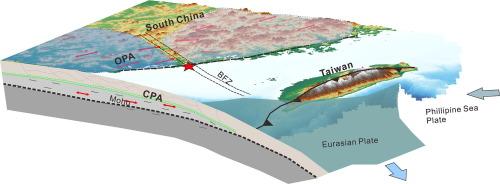中国东南部的地壳结构和各向异性:大陆碰撞与板块内部地震
IF 7.2
1区 地球科学
Q1 GEOSCIENCES, MULTIDISCIPLINARY
引用次数: 0
摘要
本研究探讨了中国东南部地壳结构和各向异性在集中和扰动构造应力背景下对板块内地震的作用。该地区具有复杂的多相构造历史,包括菲律宾板块与中国南海边缘正在发生的碰撞。利用远震接收函数方法,我们全面描述了广东和福建这两个地震多发地区的地壳结构和层状各向异性。我们的研究结果表明,地壳各向异性分为两层,中上层地壳的慢轴垂直于造山带,而下层地壳的快轴垂直于造山带。地壳结构的横向异质性和各向异性强调了大陆块之间的边界划分和差异运动。通过观察发现,跨越这一边界的板块内地震的密度和强度都有所增加,这支持了我们关于脱钩地壳变形与地震之间联系的结论。具体来说,中生代碰撞过程中变质岩的褶皱在中上地壳产生了与造山带平行的构造,而韧性剪切则在较低地壳水平产生了与造山带垂直的快速方向。与此相反,目前碰撞重新激活的大陆块体之间的错配演化为中国东南部地震的发生提供了有利的应力条件。我们的研究结果为了解板内地震背后的机制以及大陆碰撞带内的构造演化提供了有价值的见解。这些地震背后的控制因素非常复杂且不确定。本研究旨在探讨板内地震活动背景下中国东南部地壳结构和各向异性的作用。该地区目前正在经历菲律宾板块和南海边缘板块之间的碰撞,其构造历史具有多相性,包括古太平洋俯冲的遗迹。通过利用接收函数方法,我们详细描述了中国东南部两个地震多发地区--广东和福建的地壳结构和层状各向异性。我们的研究结果表明,地壳各向异性可分层为两层:中上层地壳和下层地壳,分别具有与造山带垂直的慢轴和快轴。地壳结构的横向异质性和各向异性突出了大陆块之间的边界和差异运动。跨越这一边界的板块内地震密度和强度的增强,为地壳变形与地震之间的脱钩联系提供了证据。具体而言,我们的观测结果表明:(1) 中生代大陆碰撞诱发了中上地壳的变质褶皱;(2) 韧性剪切是下地壳的特征;(3) 持续的碰撞导致了大陆块之间的错配演化,为地震的发生创造了有利的应力条件。本文章由计算机程序翻译,如有差异,请以英文原文为准。

Crustal structures and anisotropy in southeastern China: Continental collision and intraplate earthquakes
This study investigates the role of crustal structures and anisotropy in southeastern China regarding intraplate earthquakes within the context of concentrated and perturbed tectonic stresses. The region is characterized by a complex multiphase tectonic history,including the ongoing collision between the Philippine Plate and the South China Sea margin. Utilizing the teleseismic receiver function method, we offer a comprehensive depiction of the crustal structures and layered anisotropy in Guangdong and Fujian, two earthquake-prone areas. Our results reveal that the crustal anisotropy is stratified into two layers, with a slow axis perpendicular to the orogenic belt in the upper-middle crust, whereas the fast axis aligns perpendicularly at lower crust levels. The lateral heterogeneity and anisotropy of the crustal structure emphasize both the boundary delineation and differential movement between continental blocks. The observed increase in density and intensity of intraplate earthquakes across this boundary supports our conclusion regarding a connection between decoupled crustal deformation and seismicity. Specifically, the foliation of metamorphic rocks during the Mesozoic collision generated orogen-parallel fabrics in the upper-middle crust, while ductile shearing resulted in orogen-perpendicular fast directions at lower crust levels. In contrast, mismatch evolution between continental blocks reactivated by present collision provides stress conditions conducive to earthquake occurrence in southeastern China. Our findings provide valuable insights into mechanisms behind intraplate earthquakes as well as tectonic evolution within continental collision zones.
Plain Language Summary
The mechanism of intraplate earthquakes is a topic of great interest in the study of continental collision and regional tectonic evolution. The controlling factors behind these earthquakes are highly complex and uncertain. In this study, we aim to investigate the role of crustal structures and anisotropy in southeastern China within the context of intraplate seismic activity. This region, which is currently experiencing a collision between the Philippine Plate and the South China Sea Margin, has a multiphase tectonic history that includes remnants of paleo-Pacific subduction. By utilizing the receiver function method, we provide a detailed picture of crustal structures and layered anisotropy in Guangdong and Fujian, two earthquake-prone regions in southeastern China. Our findings reveal that anisotropy in the crust can be stratified into two layers: an upper-middle crust and a lower crust with a slow axis and a fast axis, both perpendicular to the orogeny, respectively. The lateral heterogeneity and anisotropy of the crustal structure highlight the boundary and differential movement between the continental blocks. The enhanced density and intensity of the intraplate earthquakes across this boundary provide evidence for a connection between decoupled crustal deformation and seismicity. Specifically, our observations suggest that (1) the Mesozoic continental collision induced metamorphic foliation in the upper-middle crust, (2) ductile shearing is characteristic of the lower crust, and (3) ongoing collision has led to mismatch evolution between continental blocks, which creates stress conditions favorable for earthquake occurrence.
求助全文
通过发布文献求助,成功后即可免费获取论文全文。
去求助
来源期刊

Gondwana Research
地学-地球科学综合
CiteScore
12.90
自引率
6.60%
发文量
298
审稿时长
65 days
期刊介绍:
Gondwana Research (GR) is an International Journal aimed to promote high quality research publications on all topics related to solid Earth, particularly with reference to the origin and evolution of continents, continental assemblies and their resources. GR is an "all earth science" journal with no restrictions on geological time, terrane or theme and covers a wide spectrum of topics in geosciences such as geology, geomorphology, palaeontology, structure, petrology, geochemistry, stable isotopes, geochronology, economic geology, exploration geology, engineering geology, geophysics, and environmental geology among other themes, and provides an appropriate forum to integrate studies from different disciplines and different terrains. In addition to regular articles and thematic issues, the journal invites high profile state-of-the-art reviews on thrust area topics for its column, ''GR FOCUS''. Focus articles include short biographies and photographs of the authors. Short articles (within ten printed pages) for rapid publication reporting important discoveries or innovative models of global interest will be considered under the category ''GR LETTERS''.
 求助内容:
求助内容: 应助结果提醒方式:
应助结果提醒方式:


